Kyrgyz cuisine: not for the faint hearted
 Anyone for fermented mare’s milk? It’s probably not something you’ve thought about drinking, but what about eating it? It’s actually possible…
Anyone for fermented mare’s milk? It’s probably not something you’ve thought about drinking, but what about eating it? It’s actually possible…
Welcome to the weird and wonderful world of the Kyrgyz cuisine, a culinary tradition that has developed out of centuries of deprivation, freezing mountain winters and time-honoured nomadic hospitality.
It’s not the Kyrgyz are wholly a deprived lot; in fact there is no shortage of dairy and meat products out on the jailoo (moors) of Central Asia. However being so far-flung in the centre of Asia, hemmed in by gigantic mountain ranges, and punished annually by winter temperatures which plunge well below zero, there isn’t an abundance of tropical fruit and spices to work with (Fun fact: the coldest recorded temperature in Kyrgyzstan was in a mountain valley, at a numbing -53 Celsius).
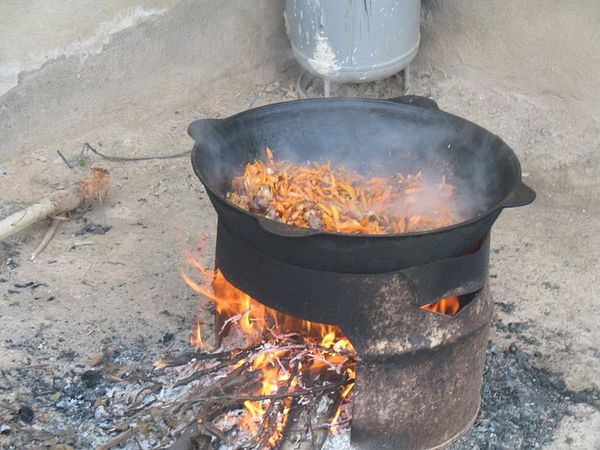
Paloo (Image: Firespeaker, Wikimedia Commons)
That explains the overall lack of spices in staple dishes like paloo (fried rice, related to the Greek pilaf or Indian pulao). A huge pot of rice with shredded carrots, onions, garlic and beef or lamb/mutton, paloo isn’t meant to be tantalisingly exotic, it’s supposed to fill bellies. Likewise manti, medium to large steamed dumplings, are won’t set your mouth on fire – they’ll warm your soul in the driving wind and rain.
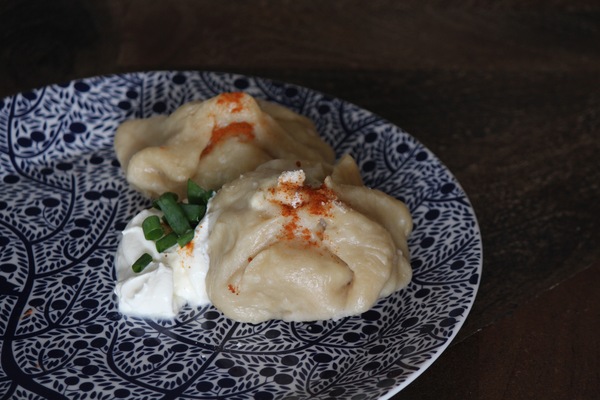
Manti (from Recipes for Ramadan)
Shashlik is another such staple; skewered chunks of lightly spiced beef, mutton/lamb or goat are served with a mountain of bread. The Kyrgyz love their bread, and it comes in a varieties resembling either the Indian/Pakistani naan, or heavier Russian-style loaves. It’s normally served with tea – black or green, without milk.
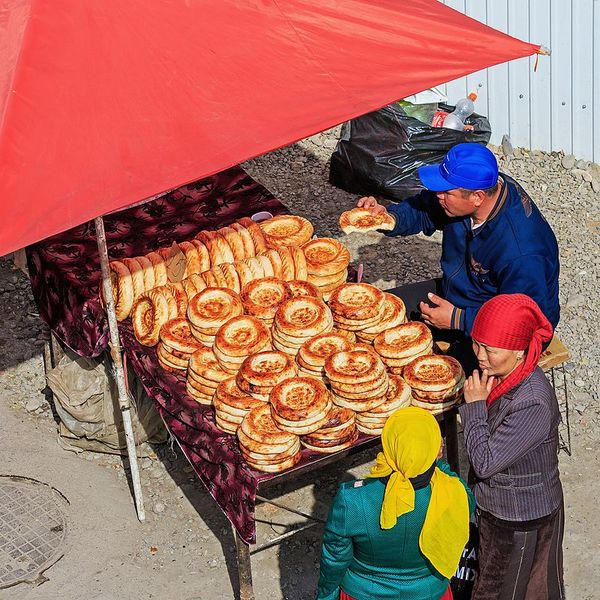
Bread in a market in Osh (Image: © A.Savin Wikimedia Commons)
The Kyrgyz also love their jams, which are made from a variety of mountain fruits such as cherry, apple, apricot, strawberry and quince. A perfect Kyrgyz snack is some fresh, warm bread, dipped in homemade jam and served with a steaming cup of aromatic green tea.
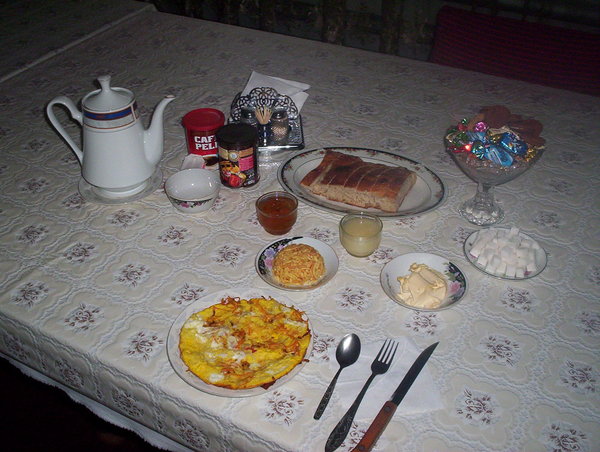
Breakfast at the Shepherd’s Life homestay in Kochkor. A vegetable omelette, savoury rice, freshly churned butter, homemade bread with apricot jam and lemon butter, some biscuits and chocolates and a pot of either green tea or instant coffee.
And then there’s the weird stuff. Nomadic tradition dictates that if a guest has just arrived in your yurt after a long journey across the treacherous ranges, you ought to lay on a spread. And by “a spread”, I mean a whole horse or sheep, slaughtered and cooked up in rice, with the animal’s cooked head sitting atop to be presented to the honoured guest. Don’t worry, you don’t have to eat the sheep’s whole head – it’s the guest’s job to carve it up for the host and their family! (Seriously, however, this might not happen to you – most modern Kyrgyz don’t have a sheep just hanging around waiting to be eaten).
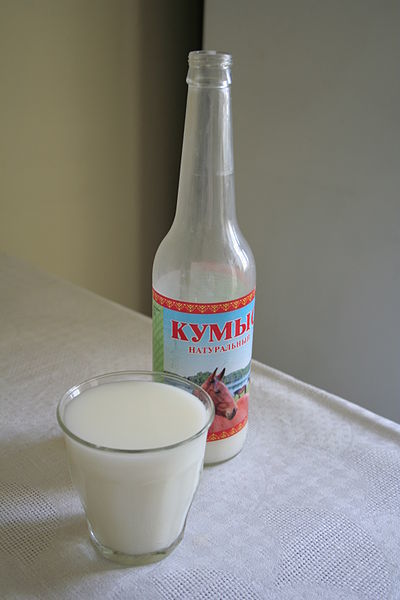
Bottled kumis. In the summer months it’s fresh, but bottled varieties are popular during the winter. (Image: Kumys-bottle © ASavin Wikimedia Commons)
Kyrgyzstan’s location in the mountains of Central Asia also means the horse and yak have a special place in the country’s culinary soul. Yak’s milk is an interesting experience, but is not nearly as popular as kumis, fermented mare’s milk. I’ve never tried the fresh milk from a young female horse, so I don’t know what the base ingredient tastes like, but if you can imagine sour cream dissolved in soda water, then you’d be close to the taste of kumis. It’s said to be refreshing when served ice-cold in summer – I didn’t think so. It’s also slightly alcoholic, and although Kyrgyzstan is 86% Muslim, the Kyrgyz gulp down kumis with abandon – I guess the alcohol content isn’t as strong as the nation’s love of their traditional drink.
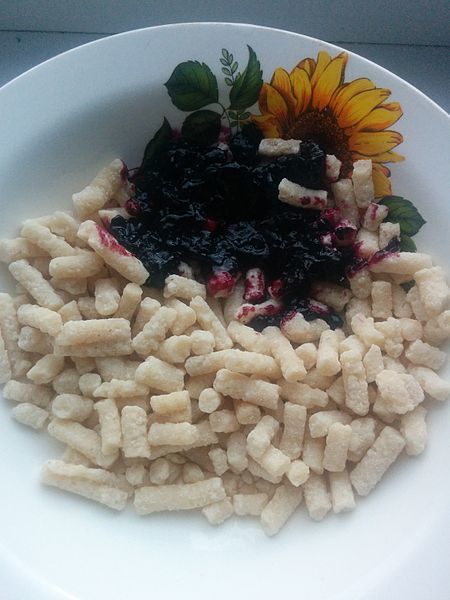
Qurut with some berry jam (Image: Agilight, Wikimedia Commons)
But nothing quite compares to qurut. These dried balls of cheesy yogurt smell just like you’d expect them to – old dried cheesy yogurt. They’re a popular grab-and-go snack in Kyrgyzstan, so much so that one of my fellow passengers in a cross-country taxi decided to pick up a bag of them to suck on while travelling.
 If you’re interested in trying some (tamer) Central Asian dishes, check out my cookbook Recipes for Ramadan, featuring five recipes from Kyrgyzstan and nearby, plus 60 more from around the world!
If you’re interested in trying some (tamer) Central Asian dishes, check out my cookbook Recipes for Ramadan, featuring five recipes from Kyrgyzstan and nearby, plus 60 more from around the world!

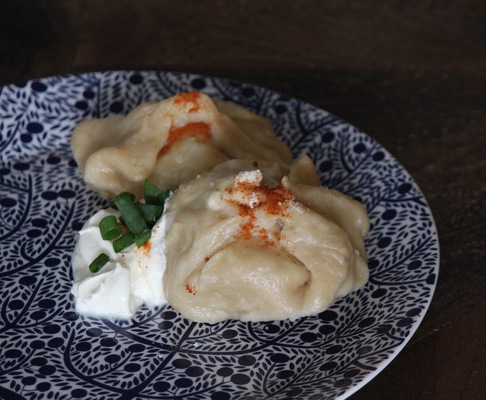



anywhere you go in central asia I found shaslik to be a great thing to fall back on! not sold on those yogurt things…
Yep – shashlik and plov are great standbys – they’re nearly always tasty, easily available, and no weirdness!
Amazing post about this Kyrgyz cuisine, Tim! You helped me discover so many new things, thanks for sharing!
Thanks for reading, Agness 🙂